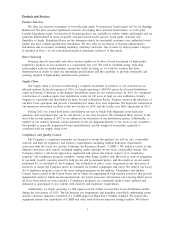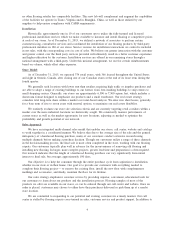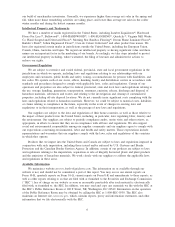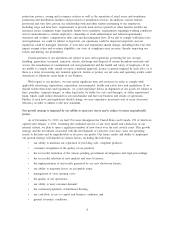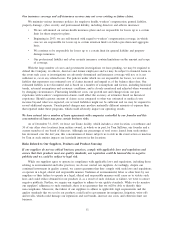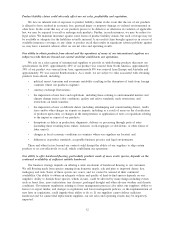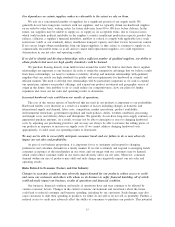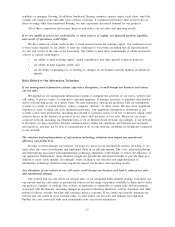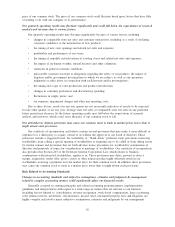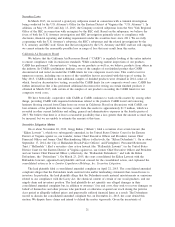Lumber Liquidators 2015 Annual Report Download - page 23
Download and view the complete annual report
Please find page 23 of the 2015 Lumber Liquidators annual report below. You can navigate through the pages in the report by either clicking on the pages listed below, or by using the keyword search tool below to find specific information within the annual report.Our dependence on certain suppliers makes us vulnerable to the extent we rely on them.
We rely on a concentrated number of suppliers for a significant portion of our supply needs. We
generally do not have long-term contracts with our suppliers, and we typically obtain our hardwood supplies
on an order-by-order basis, writing orders for future deliveries from 90 to 180 days before delivery. In the
future, our suppliers may be unable to supply us, or supply us on acceptable terms, due to various factors,
which could include political instability in the supplier’s country, insufficient production capacity, product line
failures, collusion, a supplier’s financial instability, inability or refusal to comply with applicable laws, trade
restrictions, tariffs or our standards, duties, insufficient transport capacity and other factors beyond our control.
If we can no longer obtain merchandise from our larger suppliers, or they refuse to continue to supply us on
commercially reasonable terms or at all, and we cannot find replacement suppliers, we could experience
deterioration in our net sales and operating results.
If we fail to identify and develop relationships with a sufficient number of qualified suppliers, our ability to
obtain products that meet our high quality standards could be harmed.
We purchase flooring directly from mills located around the world. We believe that these direct supplier
relationships are important to our business. In order to retain the competitive advantage that we believe results
from these relationships, we need to continue to identify, develop and maintain relationships with qualified
suppliers that can satisfy our high standards for quality and our requirements for hardwood in a timely and
efficient manner. The need to develop new relationships will be particularly important as we seek to expand
our operations, enhance our product offerings, and expand our product assortment and geographic source of
origin in the future. Any inability to do so could reduce our competitiveness, slow our plans for further
expansion and cause our net sales and operating results to deteriorate.
Increased hardwood costs could harm our results of operations.
The cost of the various species of hardwood that are used in our products is important to our profitability.
Hardwood lumber costs fluctuate as a result of a number of factors including changes in domestic and
international supply and demand, labor costs, competition, market speculation, product availability,
environmental restrictions, government regulation and trade policies, duties, weather conditions, processing
and freight costs, and delivery delays and disruptions. We generally do not have long-term supply contracts or
guaranteed purchase amounts. As a result, we may not be able to anticipate or react to changing hardwood
costs by adjusting our purchasing practices, and we may not always be able to increase the selling prices of
our products in response to increases in supply costs. If we cannot address changing hardwood costs
appropriately, it could cause our operating results to deteriorate.
We may not be able to successfully anticipate consumer trends and our failure to do so may adversely
impact our net sales and profitability.
As part of our business proposition, it is important for us to anticipate and respond to changing
preferences and consumer demands in a timely manner. If we fail to identify and respond to emerging trends,
consumer acceptance of the merchandise in our stores and our image with our customers may be harmed,
which could reduce customer traffic in our stores and adversely affect our net sales. Moreover, consumer
demand within our mix of products may shift and such change may negatively impact our net sales and
operating results.
Risks Related to Economic Factors and Our Industry
Changes in economic conditions may adversely impact demand for our products, reduce access to credit
and cause our customers and others with whom we do business to suffer financial hardship, all of which
could adversely impact our business, results of operations and financial condition.
Our business, financial condition and results of operations have and may continue to be affected by
various economic factors. Changes in the current economic environment and uncertainty about the future
could lead to reduced consumer and business spending, including by our customers. Such changes may also
cause customers to shift their spending to products we either do not sell or do not sell as profitably. Further, a
reduced access to credit may adversely affect the ability of consumers to purchase our products. This potential
13


